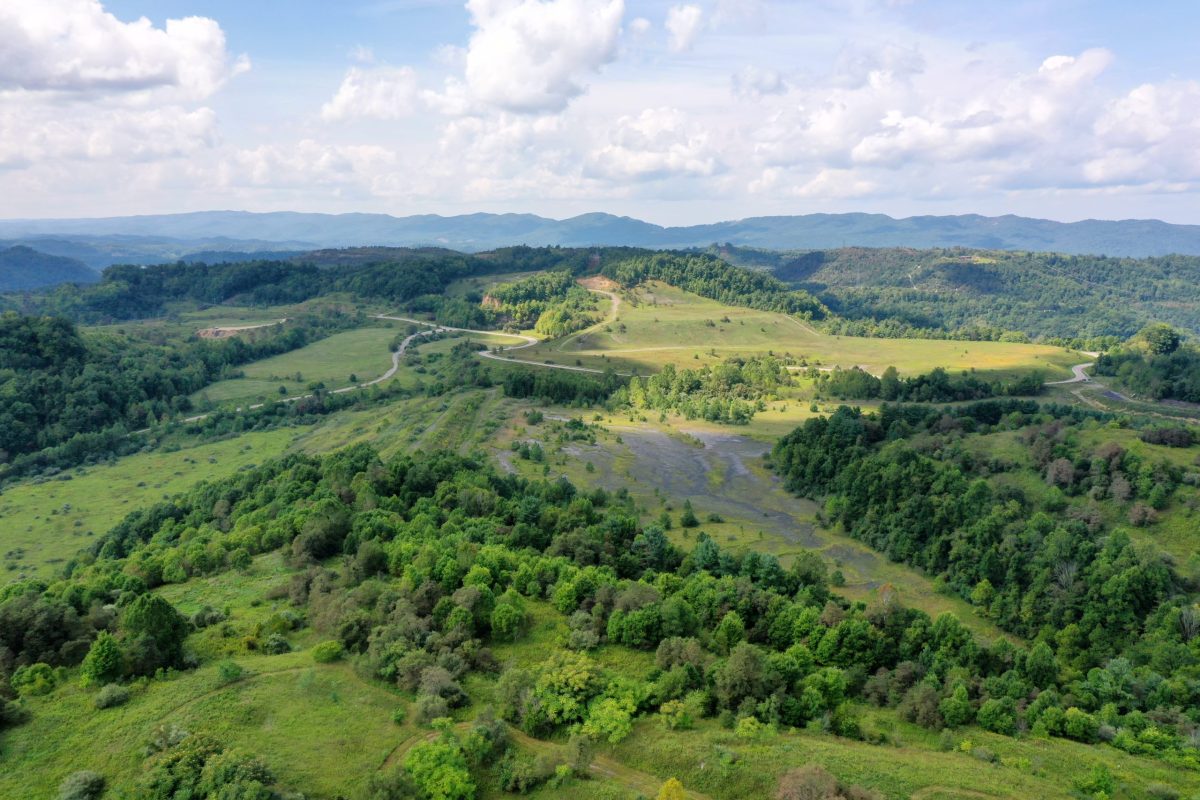The force of it still resonates. So much water, so fast, and with it, homes thrust off their foundations, campers and trucks swept miles away, boats now grounded a ways from any shore.
In just moments, it was over; in its wake, six dead, more than $300 million of destruction, families left homeless.
On Tuesday, August 17, rains from the remnants of Tropical Storm Fred hit Haywood County in rural, mountainous Western North Carolina. More than 10 inches of rain fell very quickly; water levels reached up to seven feet above their previous highs. Particularly hard hit were the communities of Cruso and Bethel and the towns of Canton and Clyde.
Now the community is at work, clearing and rebuilding, putting to rest the past. But emotions are easily triggered.
Sheila Snyder stands in front of the home in which her mother, Bobbie Jean Bumgarner, 83, has lived all her life.
“The water blew in through the basement door,” Snyder says. Bumgarner, who lives alone, had gone downstairs. “She thought that she could put some stuff up on some tables so the water wouldn’t get to it, bless her, which is what happens when it rains really hard; water gets in the basement.”
But this was different. Bumgarner then heard a noise.
“She said it sounded like something she’d never heard: thunder; something. It was the water coming,” Snyder says, her voice wavering. It entered the side of the house and into the basement. Bumgarner started back up the stairs, the water lapping at her heels. “That quick.”
Today, a community has pulled together.
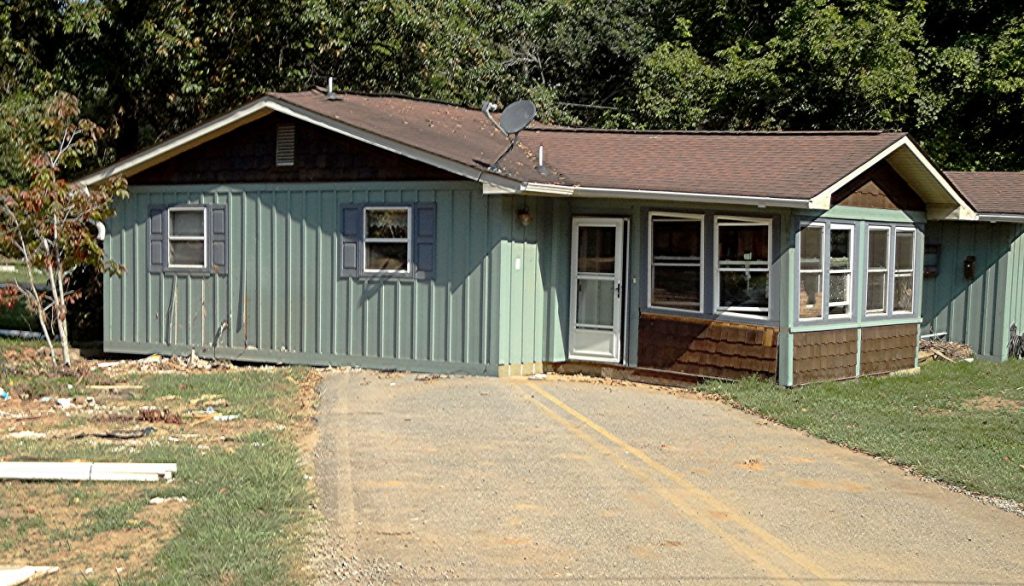
“I can honestly say that Western North Carolina people rally,” says Patsy Davis, executive director of the community-based nonprofit Mountain Projects. “People support one another. The outpouring of support has been just absolutely amazing.”
Community members are offering furniture for her mom, Snyder says. “We’ve got people who want to paint. They’re contract painters and they’re going to paint for free.” Again, her voice breaks. “It’s amazing.”
But this disaster has underscored ongoing issues that are beyond a community’s collective good will. Affordable housing in the region was already scarce; the number of homeless has now mounted.
And there’s a yet more fundamental issue, one shared by millions beyond this Appalchian community. A September study found that nearly one in three Americans had experienced a weather disaster this summer.
“You just can’t argue with the physics,” says Rob Young, director of the Program for the Study of Developed Shorelines at Western Carolina University. The reach of climate-fueled disasters is widening. With a warming planet, Young says, storms are supercharged by heat and are able to hold more water. That moisture is then transferred farther inland.
“I don’t think that there’s anything unique about that particular watershed or those communities,” Young says of Haywood County, “that makes them more vulnerable than other areas in the southern Appalachians.”
And, he adds, “that increased amount of rain in the weather systems that we’re seeing doesn’t apply just to tropical systems that are coming inland. It applies to weather writ large.”
‘I Need You To Shut the Door’
“It just roared,” Bobbie Jean Bumgarner says. “It was so sudden.”
Bumgarner went out on her porch and within minutes the Cruso Fire Department arrived by boat to check on her. She called her daughter, who arrived 20 minutes later. By then, the water had passed. It had left an awful mess.
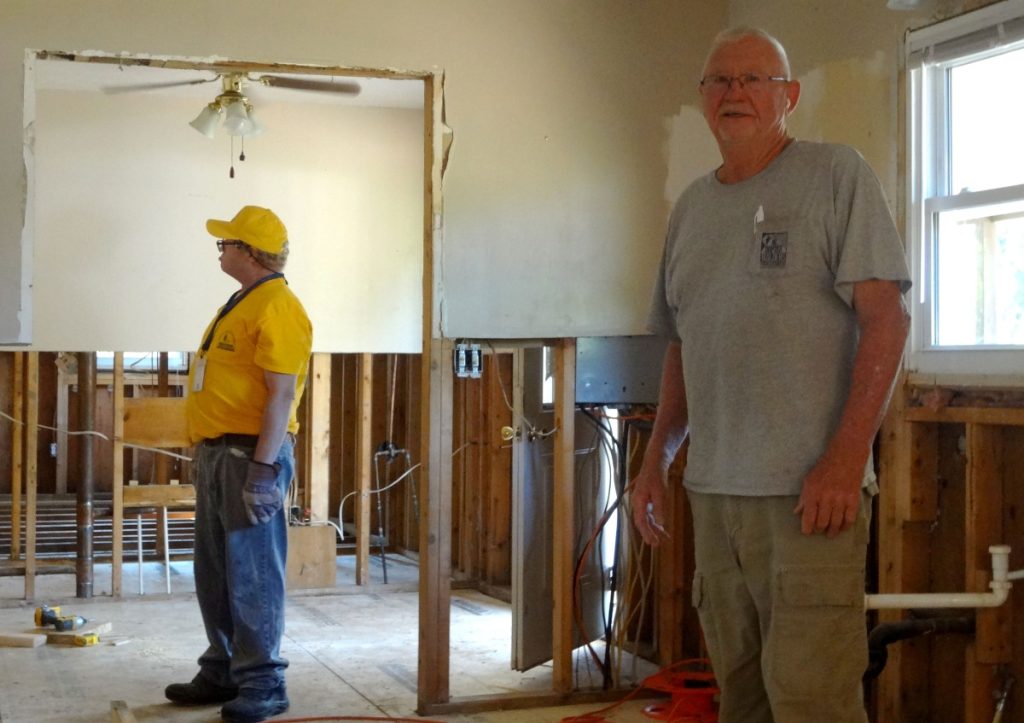
The next day, Baptists On Mission, based in Cary, North Carolina, arrived in Haywood County, mobilizing its Emergency Rapid Repair program. Bill Martin, now well known in the area as “Bill the Baptist,” is coordinating the effort.
“I’ve been doing this a long time,” Martin says. “I’ve been doing it since [Hurricane] Andrew,” in 1992. “This is the worst I’ve ever seen for concentrated destruction.” Scooped between mountains, these communities were hostage to the water.
Bumgarner’s house is among those Martin’s teams are repairing. Another is the home of Carroll Pressley, 92, and his wife Mary Ellen, 85, just up the road in Cruso, a home in which they’ve lived since 1956.
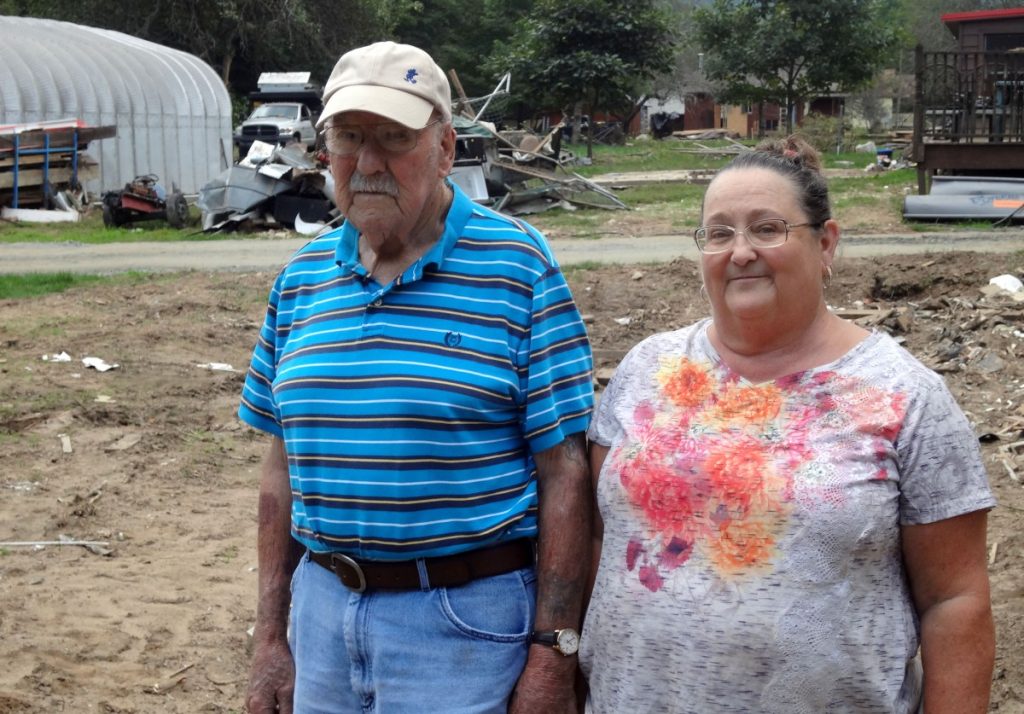
“They lost their hot-water heater, the furnace, all the duct work,” their daughter, Carolyn Wilson, says. “Bill and his crew came and did more in two hours than we’d done in three days.”
Wilson is still shaken by memories of the day. She lives just moments from her parents. By the time she reached their house, “water was just gushing out of the mountain like a waterfall. I mean, it was coming from everywhere.”
“Mom kept saying, ‘I need, I need …’ And I said, ‘I need you to shut the door. We’re going now.’ I barely got her in the car.”
Her mom now says, “All I need is water and some heat and I’m going home.”
Wilson thinks otherwise.
‘Nothing Like That’
Next door, Crystal and Victor Mancia survey the debris – little of which belongs to them – across their riverside five acres. Their property is at a bend in the river. The body of one of the six who were killed washed up here.
The Mancias came down from Wisconsin, fell in love with the mountains, the region, and settled here in Cruso. They fashioned a little camping area in their yard, a pavilion with running water and electricity.
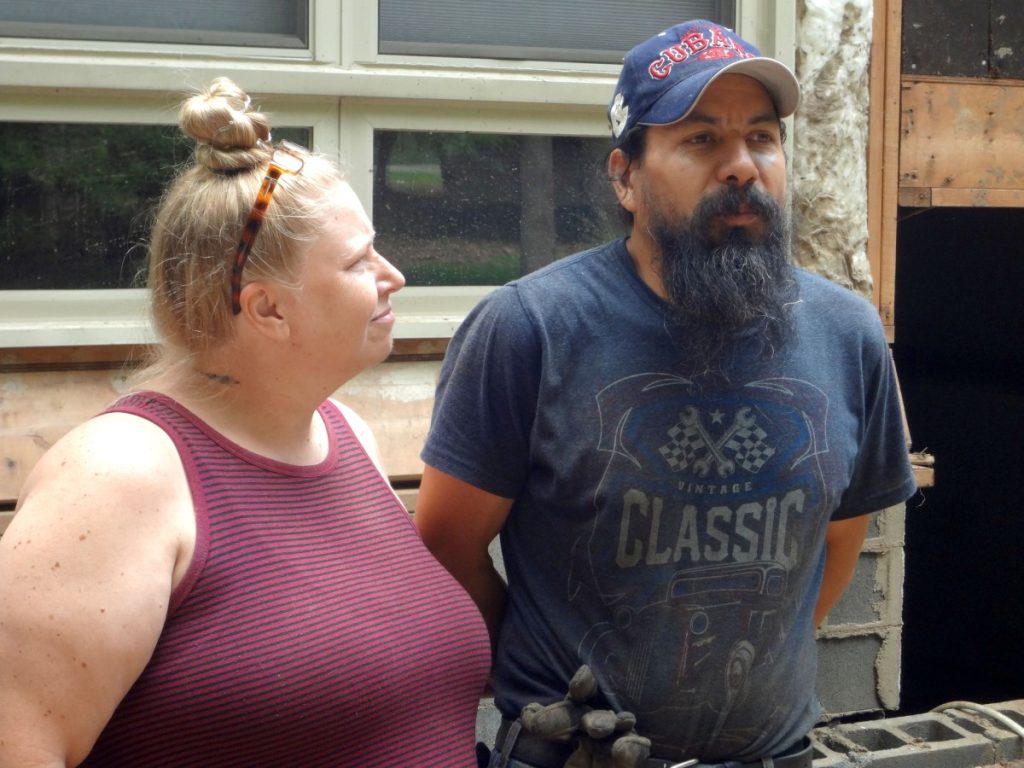
“This was supposed to be our home of hospitality,” Crystal says. “That was the idea. We were able to host one thing: One of the folks from our church was getting married, so we had the men over here and they did a barbecue.”
They’ve remained in their home as they rebuild. Strangers drive by, slow down, stick their phones out the window and snap photos. “We’re like a freakshow, honestly,” Crystal says. They press on, patching things up, lending a hand to the Pressleys. Life these days, she says, “ebbs and flows.”
Down the hill, Steve Henson describes how after the storm he found his dump truck floating in a circle, “just like a duck.”
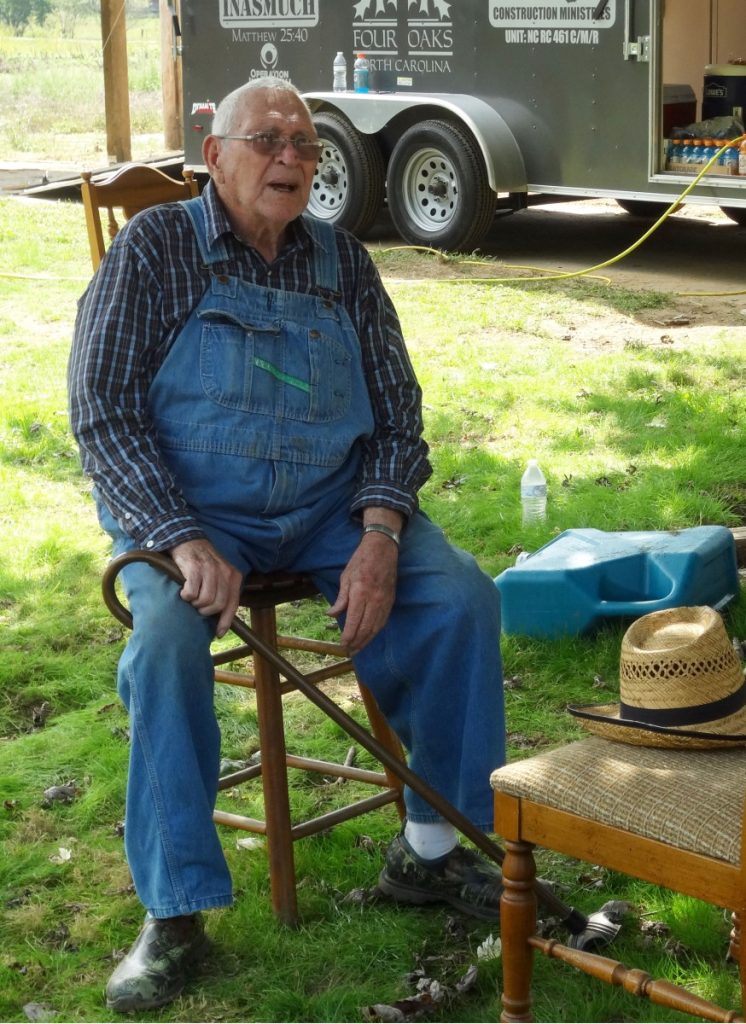
He lives right next to his dad, Roy Henson, who’s 85. Steve had just come in from working when he got a call from his sister: “Can you go help Daddy?” “And I said, ‘Yeah.’ I said, ‘I just left down there. What’s going on?’ She said, ‘Well, he just called me and said he was wet to his knees.’” Maybe five minutes had passed since Steve had passed his dad’s house.
“I just jumped in the truck and I got to the mailbox, and that’s as far as I made it,” he says. “I still can’t wrap my head around it.” A neighbor helped Roy get out of his house.
“I’ve seen the river get up,” Roy says, “but not nothing like that.”
A Bad Situation Worsened
The house Donella Pressley lived in with her two young daughters, Cordelia and Elena, was devastated.
“I couldn’t get far enough away from Canton that day,” Pressley told Mountain Projects in an interview for an article on their website. Then folks arrived to help: neighbors, Bill the Baptist and crew. “[N]ow I can’t see how I’d ever leave. It’s been a very humbling experience.”
But for those whose homes are irreparable, the future is far less certain.
“We had a severe housing shortage prior to this,” Mountain Projects’ Patsy Davis says, “and this just made it worse. We’re working hard to try to find solutions and look at the big picture.” She has “big dreams,” she says, but little money.
On Sunday, Sept. 19, an event was held in front of the courthouse in Waynesville, the Haywood County seat, called “March on Cawthorn: Rally for Climate, Jobs, & Relief in Appalachia Now.” It was organized by the Sunshine Movement and called for “a fully funded Civilian Climate Corps and bold investment in renewable energy, public housing, transit, and schools” for Appalachia. Madison Cawthorn is the region’s representative in Congress.
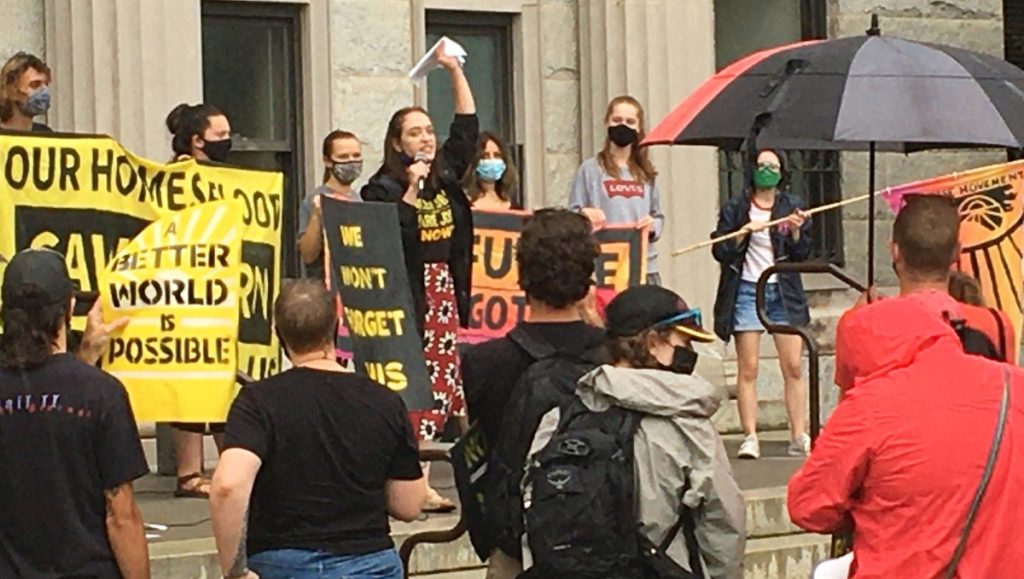
“What’s happened in these last few weeks has been beautiful, Chelsea White, 27, a local activist, said in a post-rally interview. “I’ve watched my community come together like we always do to care for one another. We’ve been organizing a grassroots mutual-aid effort to keep folks fed and warm and safe and make sure that everyone has a bed to sleep in.”
“We’ve been left behind,” White said. She feels that Cawthorn, who’s become a rising star on the far right, is neglecting his constituents’ needs – that he and the region’s other federal elected officials “haven’t shown up like we’ve shown up for each other.”
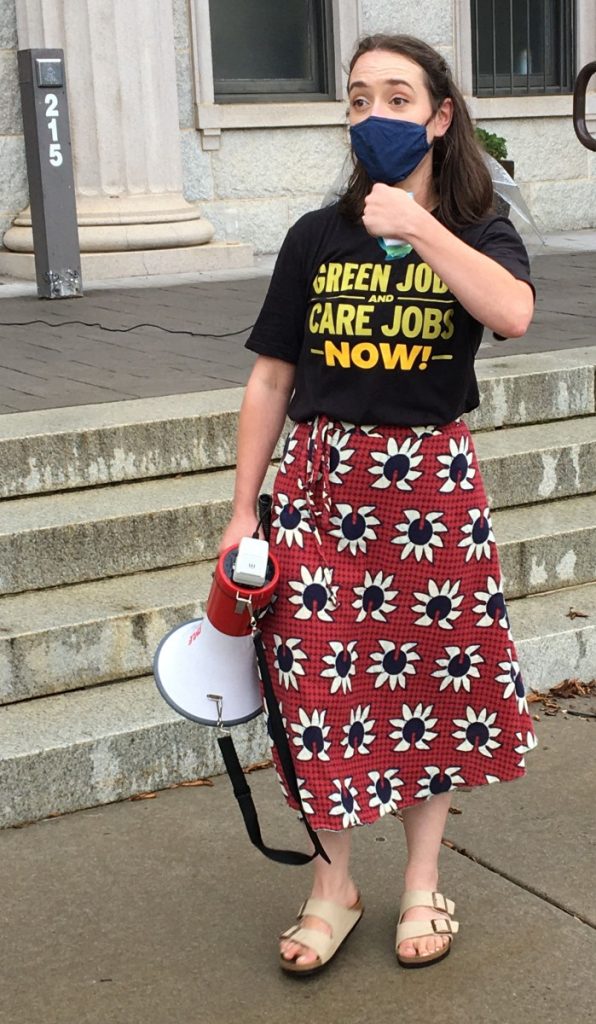
The average age at the rally was perhaps a decade or two younger than that of the residents of Cruso and Bethel. Whether the message conveyed regarding the climate would be embraced in those communities is questionable. Given the exigencies of their lives today, examining the effects of climate change is a hard sell.
But these young activists speak out from a sense of deep tradition.
“As someone who was raised by generations of revolutionary rednecks, I see it as my job, our job, to carry on the legacy of our Appalachian ancestors,” White told the crowd. “Not just to care for each other, but to fight on the front lines for the change that will allow our neighbors, our children, our communities to thrive.”
Addressing climate change is central to that.
A Difficult Message
“It isn’t that Haywood County, North Carolina, is particularly susceptible to exposure to, or vulnerable to, a rain event like the one that we had,” Rob Young of the Program for the Study of Developed Shorelines says. “It can happen in a lot of little watersheds and in valleys from here up through Virginia, West Virginia, Pennsylvania.
What can be done to guard against loss of life and property damage in events such as these “is to not put people in harm’s way,” Young says. “And hopefully, whatever rebuilding happens following this storm will happen in a way that will make people safer.”
“The problem is that people don’t really like to be told what to do,” he adds. “We’re talking about very independent people.”
For families on land that goes back generations, moving even a few miles down the road might be unimaginable.
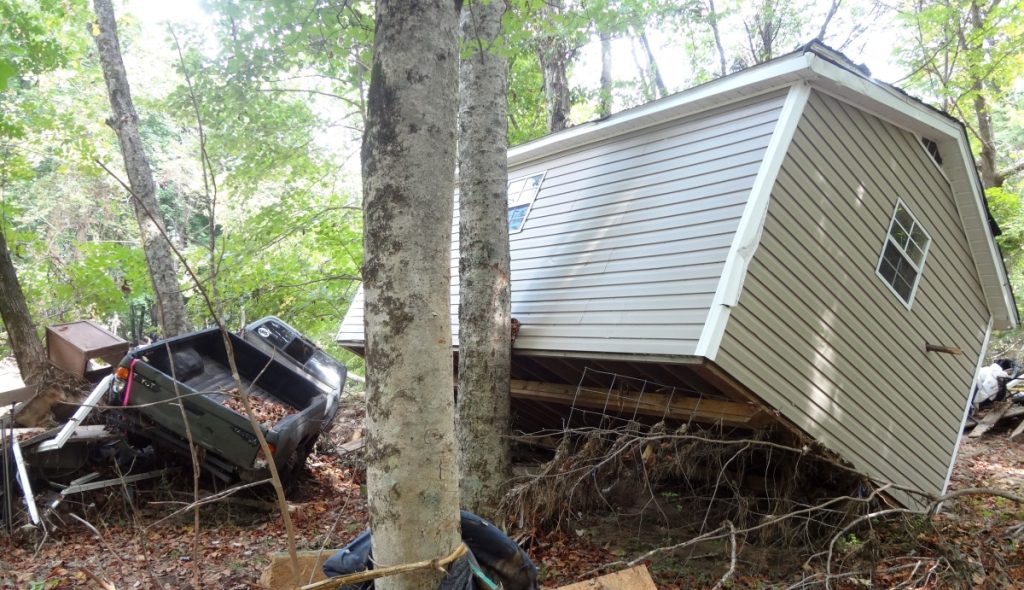
Bobbie Jean Bumgarner’s husband’s brother-in-law, who lives just up from her, refuses to go live with his son or daughter “because he can’t leave Joanne,” his wife, “and she’s been dead for years.” But she’s buried there in the graveyard. “He’s just stubborn,” Bumgarner says.
Young would like to see a program launched that makes federal or state funds quickly available after an event like that in Haywood County, “so that those who wanted to could do something different” in terms of how they rebuild or where they choose to live.
“Some people wouldn’t be interested,” he allows. “But some people probably would. Because I guarantee you there are some folks in Bethel and Cruso that don’t want to go through that same thing again,” awakening to an echo of “that water pouring down the valley.”
Carolyn Wilson lost everything in the flood that overwhelmed the town of Clyde in 2004. “Dad had property right up the road, so I relocated. I never thought I’d have to do this twice,” she says, the memory of it overcoming her. “This one was 10 times worse.”
Taylor Sisk is 100 Days in Appalachia’s health correspondent. Support his work and our continued coverage of health care and access in the region by donating here.


